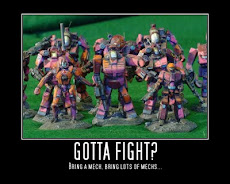I've been working on some of the serried ranks of toy soldiers that I have on my shelf awaiting some brush love. This includes the MechWarrior: Dark Age/Age of Darkness clix figures that are a good match for Pendraken's 10mm range, which I'm now using for my infantry in
BattleTech games. What I have is 9 platoons of figures waiting for me to progress them further along the route to being deployed in a game. That's about 300 figures, give or take.
Four of the platoons are made up as specialist weapons. Either snipers, rocket launchers, heavy lasers, and flame thrower platoons. I just finished basing the remaining sniper and flamethrower figures this weekend, and when I have primed them, added a bit more texture to the bases, and drybrushed the base coat, all of the platoons will be at the same stage of incompleteness.
BattleTech works around 28 men platoons, but I've only used 27 figures, as my feeling is that two sections of 13 men, with a commander feels right to me. However, part of me thinks that a platoon of specialist weapons is not the way they would be fielded in real life. Okay, BattleTech is not real life, but what I mean is how does on deploy such assets on the field of battle?
My instinct suggests that one would assign either squads, or sections as support to generic infantry platoons. Squads being six men, and sections 13 men. However, this may be a bit too 20th Century of me, and perhaps I need to think a bit more laterally about the ORBATs?
Anyway, I also have two 21 man jump infantry platoons, and two 21 man, and one 36 man, battle armour platoons. at the same stage of the painting production line that I have. The latter 36 man platoon is a Word of Blake Purifier battle armour unit. So, all in all, quite a lot of infantry requiring painting.
My original plan was to use all the infantry with my Demi-Brigade armour formation that I have, but my intent now is to have only battle armour or jump troops to go with the vehicles and all the plain infantry will form the basis for a generic planetary militia defense force. With this in mind I have assembled support platoons for the specialist infantry platoons, and plan to expand my generic infantry from one platoon, to as many as I need.
A figure I've not yet worked out, but probably at least one generic platoon per specialist platoon, but I might end up having two generic platoons per specialist one. We shall see how I feel in due course, after fielding some formations in a game or two. Another option is to have Company combat groups with generic infantry, specialist and integrated support and artillery assets all together. Might work quite well in fact.
The support platoons will be made up of mechanised infantry. These are defined under the BattleTech rules as infantry who fight from light vehicles; jeeps, quad bikes etc. The artillery assets will be made up of sections of mortars, heavy machine guns, light towed artillery auto-cannons, and gauss rifle battery's. In addition, I have a rocket battery's based up too. All a bit ad hoc, but this only adds to the charm of planetary defense militia.









.png)





